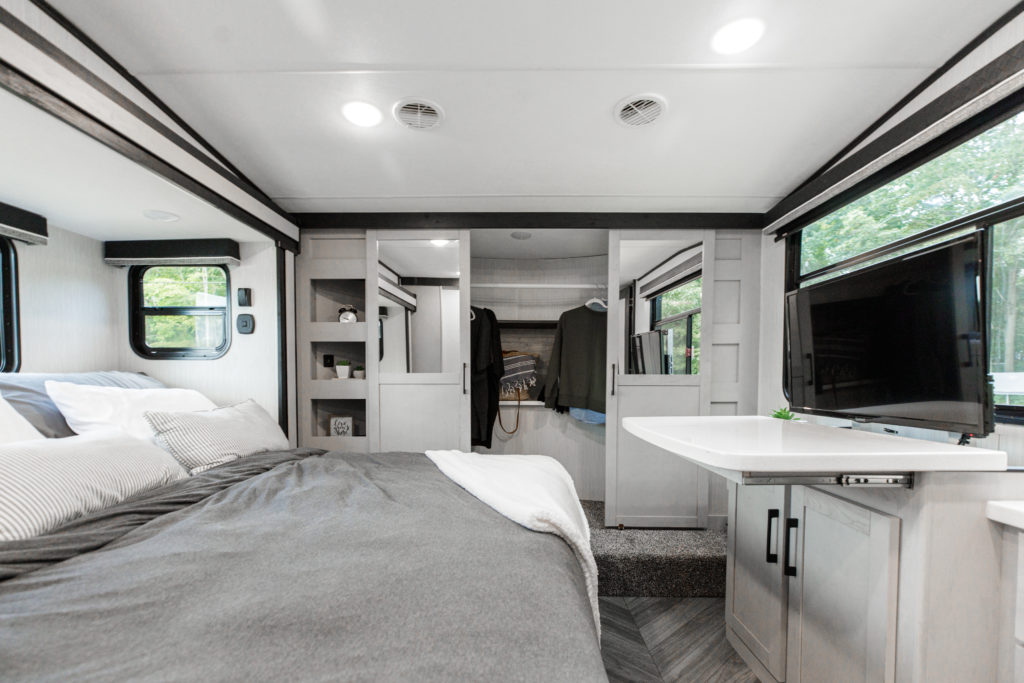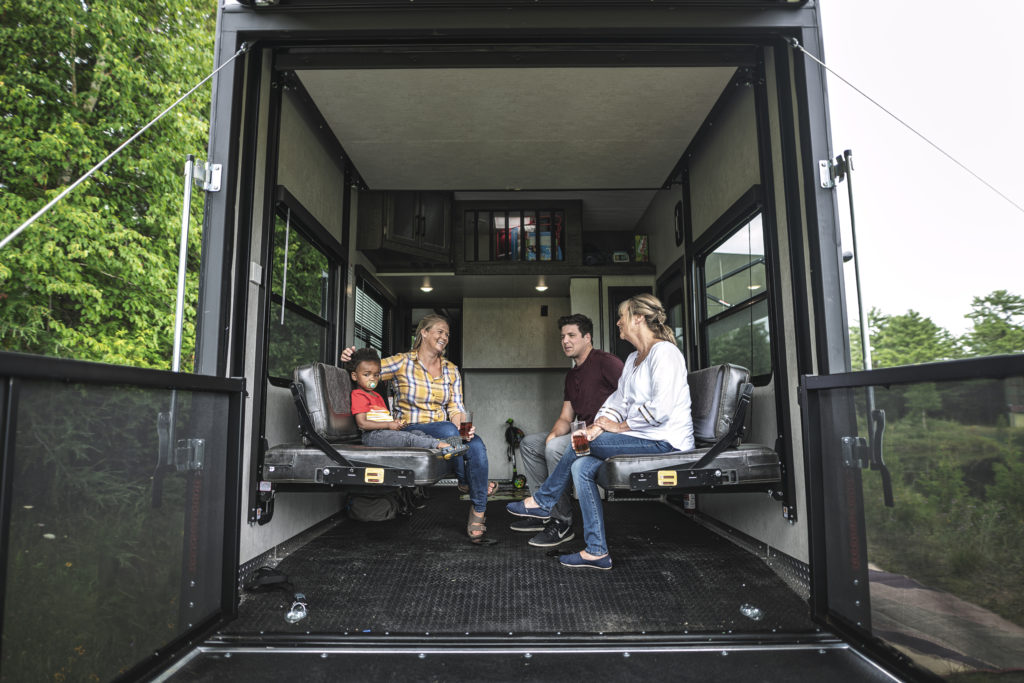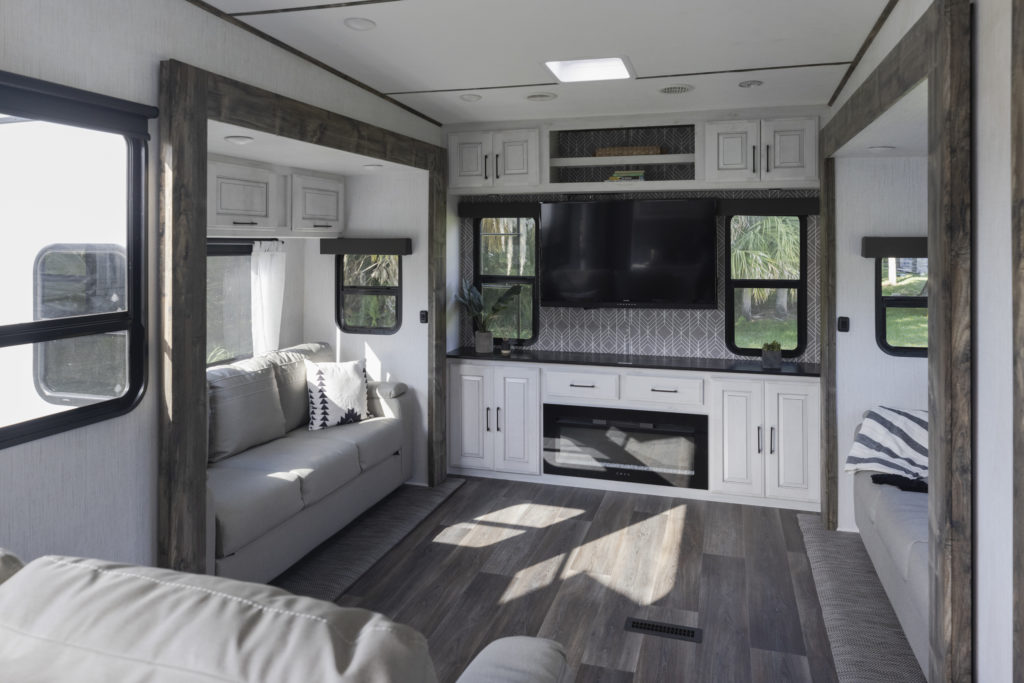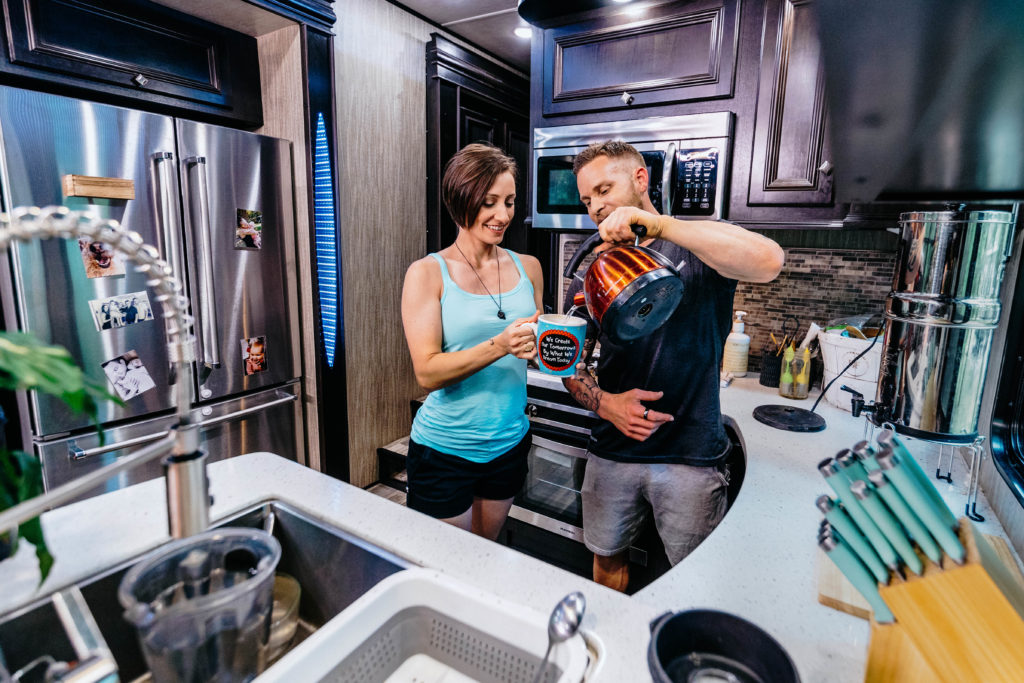Maximizing Your RV Sleeping Arrangements and Bedrooms
Part of what makes RVing such an amazing way to travel is the ability to be with your favorite people. You might travel with family, spend time with a sibling and their kids, catch up on gossip with your mom, or take your grandkids for an epic American road trip. So being able to maximize sleeping arrangements in your RV to better accommodate all of your guests is important.
RVs make the perfect way to travel because they’re so adaptable. Models are built specifically with an eye toward squeezing in as many sleep spaces as possible. It’s not even necessary to have a huge RV to sleep a crowd – some of our smaller RVs under 23 feet can sleep up to 8 people, no problem!
But sharing a small space with family or friends can come with its share of challenges. So let’s talk about the different kinds of sleeping arrangements RVs can offer, what their benefits and drawbacks are, and how to make the most of each one.
Sleep Arrangements In An RV
Master Bedrooms
Just like a typical home, every RV comes with a master bedroom, because it’s just a fancy way of saying “main bedroom.” Which means even if there’s only one bedroom on board, you’ve got yourself an RV master bedroom.
These bedrooms offer a sleeping arrangement that most typically resembles a sticks-and-bricks home. Typically, there’s a king- or queen-sized bed, a closet that could range in size from small to walk-in, a small dresser and some bedside tables or cubbies. If your RV is a miniature or small model, some of these features may be condensed or eliminated – like having one bedside pocket instead of bedside tables, or a shirt-sized closet with no dresser.
If you have a larger or more luxurious model, the main bedroom may also have its own entrance to a full bathroom, a second TV you can watch from bed, under-bed storage and other details that make the space more comfortable.
For example, the Cyclone 3511 takes things a step further with a king-sized bed that can tilt-up for added comfort. The Big Country 3851MO has a spacious master bedroom with washer/dryer prep in the closet. And the North Trail 33BHDS provides a main bedroom with an ensuite bathroom and a separate, bonus linen close
What it's Good For
Master bedrooms provide an RV interior bedroom that’s perfect for a pair or an adult traveling with kids or pets. Everyone loves a bigger bed, and the main bedrooms often come with mattresses that are most like residential mattresses, providing plush comfort on the road. In the event that you’re traveling with several other people, the master bedroom is typically claimed by the RV owners. But if you’re traveling with elderly parents or someone with specific health concerns, you might decide to give them the biggest bed and thickest mattress out of respect.
Drawbacks
A master bedroom is often one of the largest spaces in an RV. So a single person traveling alone or with friends, might make it feel like wasted space that could’ve been used for alternate sleeping arrangements.
But honestly, who doesn’t love a master bedroom? There’s nothing like it for comfort, privacy and good sleep.
Maximizing Master Bedroom Space
When traveling solo or as a couple, the main bedroom is already pretty optimized. But when you start to add in other guests, every inch of sleeping space can make a difference. When you're trying to get the most out of sleeping arrangements and you’re un-partnered, consider having any guests who normally sleep together take the master bedroom so none of that bed space is wasted.
There are RV models that come with double- or queen-sized secondary sleeping spaces, but many bunk beds are twin-sized. Smaller beds are perfect for smaller people and children, while fold-out beds in main areas would be great for whoever wakes up the earliest. That way, by the time everyone else is awake, the common areas will already put back together for the day.
Bunk Beds
RVs with bunk beds are a camping classic. And RVs with bunk beds configure them in all kinds of ways. For instance, you might find them tucked into a corner with a diagonal opening at the foot. Or built in a pass-through area with curtains for privacy. You might also find them stacked strategically in a bunk house with a door you can close at night.
As mentioned above, RVs with bunk beds often offer twin bunks, but you can find double- or full-sized bunk beds, as well. Additional configurations can come with an upper twin bed and a lower, convertible piece of furniture that can transform into a bed at night. There are also bunks that can fold-out, as needed.
If you’re looking for RVs with bunk beds, we can give you options. The Elkridge 37BBH features two full-size bunks with an efficient loft space. The Torque T281 has a spacious toy hauler garage with opposing fold-down sofas and a power queen bed loft. And the Prowler 172BHX has double-over-double bunk beds and convertible sleeping spaces that fit up to 8 people in a trailer shorter than 23 feet long.
What They're Good For
Bunk beds are great for giving people some small measure of privacy when you’re traveling with multiple people. Kids tend to find them fun and festive, while adults may appreciate having a bed to call their own, in a space where they can store their things during the day.
Unlike convertible sleeping arrangements in common areas, non-convertible bunk beds offer a permanent space for people to retreat to during the day. Whether you’re traveling with small children who still need a nap during the day, moody teenagers who might need a break from family time, or garden-variety introverts who just like to zone out for a while, bunk beds offer it all.
Drawbacks
Bunk beds can come with height-related challenges. For one thing, upper bunks may present a challenge for younger kids who could potentially fall out, although not every bunk bed is open along the length of the side. Some open at the foot, which means a sleeper would be safely encased on the left and the right while they sleep.
But another height issue with bunk beds is that they’re short on vertical space. Kids may be able to sit upright on a bunk bed, but most adults will find they’re only comfortable laying down. And even then, it can feel a little claustrophobic. If you’re traveling with anyone who’s particularly tall or on the larger side, bunk beds may not be their first choice of accommodations.
And finally, they can be tricky for some people to get out of in the dark. If any of your guests have to get up frequently to use the bathroom at night, they may not be as comfortable in a bunk bed.
Maximizing Bunk Bed Space
There are a lot of things you can do to make bunk beds more functional and comfortable. Make sure everyone has comfortable bedding and pillows. With the limited height space, providing lots of plush pillows can ensure bunk sleepers are able to get comfortable in a number of positions while they’re laying down.
You may also choose to install curtains around bunk openings to provide a little extra privacy. Especially during summer months with high temperatures, guests may be more comfortable sleeping in fewer night clothes, which means that privacy can be a functional as well as a thoughtful touch.
If bunk beds don’t already come with their own bedside lights, consider installing battery-operated push-button lights so people can see their surroundings at night. Some people might like to read before bed, while others may just need to sort through their bags to find a pair of earplugs or a nighttime medication. These push- button lights can often just be stuck to RV walls with command hooks, poster putty or their own sticky backing.
During the day, use bunk beds as cubbies to keep people’s possessions tidy and off the floor. They’re the perfect place to store bags, jackets, and bathroom caddies for individual guests when they’re not being used for sleeping.
Bunkhouses And Three Bedroom RVs
A bunkhouse is a separate room that holds bunk beds behind a door you can close. And because master bedrooms can close and bunkhouses can close, that also leaves the middle, common room as a closed-off third bedroom at night, too.
Like standard bunk beds, bunkhouses offer more individual sleeping areas that are great for privacy, peace and quiet. But bunkhouses often have other complementary features. For example, some bunkhouses include a secondary dinette table that can convert into a bed, which provides a makeshift desk or bonus eating space during the day. They might also include flexible storage space, using bunks that can flip up or down to create a modular, customizable area. Flip the lower bunk up, and you’ll have more floor space, perfect for storing bikes, a kayak or other sporting equipment, especially while you’re driving.
If you’re in the market for a bunkhouse RV, check out the Pioneer BH281 with its double-over-double bunks with storage. The Trail Runner 321BHQB has a bunkhouse that includes a full-sized bed below, and two separate twin-sized bunks in an L-shape above it. Another great floor plan option, Trail Runner 30RBK features a bunkhouse with a dinette and a flip-up bunk above. If you want double-bunks that can convert to provide storage space on the floor, check out the Prowler 323BR.
What They're Good For
Bunkhouses and three bedroom RVs are great for hosting guests within multiple, semi-private areas. Bunkhouses may be ideal for kids, as they tend to go to bed earlier than adults. Having a door you can close means you can put the kids to bed and continue chatting with your friends or family members while they try to sleep. (It’s also more fun for the kids, kind of like being at sleep-away camp or a slumber party. Who doesn’t love that?)
Bunkhouses can often double as a flexible home office space, too. If you’ve got that secondary dinette table in your bunkhouse, it’s perfect for setting up a laptop, writing things out, or using for taking meetings or phone calls. The bunkhouse door can cut down on exterior noise or create privacy for people who need to take sensitive calls or do deep-focus work in peace.
Three bedroom RVs are also great for delineating space among guests. If the kids are in the bunkhouse and the RV owners are in the master bedroom, that means any common area with a fold-out couch or dinette that transforms into a bed becomes its own little oasis. Even though it’s not a bedroom during the day, it allows guests to have a serene space of their own at night.
Drawbacks
If you’ll mostly be traveling with other adults who are in pairs, or older folks whose mobility isn’t as good as it used to be, a bunkhouse may not be your ideal option. Instead, you might look for floor plans with more fold-out and convertible bed space. These configurations make sure no one has to climb in and out of a narrow space or sleep up high.
Couches that convert into beds tend to be on the larger side, like a double or queen bed, which may be more comfortable for people in relationships. And while bunkhouses can create a sense of privacy and coziness, there are times when that set-up may not be wanted or needed. If you’ve put all your kids in the bunkhouse together, that can be fun; if you’re traveling with a bunch of unrelated teenagers, you may not want to house them all together behind a door that closes.
Maximizing Bunkhouse Spaces
Like the recommendations for optimizing bunk beds above, you’ll want to ensure everyone has comfortable bedding with plenty of pillows to make the most of their limited space. You could add some strategic curtains with tension rods or temporary stick-up hooks, and make sure everyone has a light they can use however they like.
If your bunkhouse comes with beds you can configure into different types of spaces, you may want to use this area for storing or securing larger items, especially while you’re driving. And if you’ve got a coveted second dinette table in your RV, adding a push-button light or some strategic office equipment like a pocket or file shelf on the wall could go a long way to making the most of that space to get work done.
Convertible Sleeping Setups
In a well-designed RV, no space is wasted. If you have a sofa and a loveseat in the living area, they most likely do double duty as fold-out beds. Dinette tables can often convert into a sleeping nook by rearranging the cushions. And if you’re lucky enough to have a toy hauler garage, you may have some have a loft area or fold-down beds that can be raised out of the way.
To sleep a crowd in a small trailer, check out the Prowler 181BHX, with a fold-down queen-size murphy bed, double bunks and a spacious convertible dinette. The Fuel 362 offers a master bedroom, fold-down sofas and a power queen bed in the garage, and a convertible couch and dinette to sleep up to eight people. The Bighorn Traveler 37RD makes the most of a spacious living area with two convertible couches in a floor plan that sleeps up to 6.
What They're Good For
Convertible sleeping setups are great for people who want flexibility. You could travel solo or as a twosome and have plush, theater seating, a comfortable couch with USB ports, and a roomy dinette for romantic dinners for two. And then, when you decide to travel with guests, all those things can double as comfortable sleeping arrangements in a pinch.
Convertible beds may also be more accessible than bunks for older folks, anyone with mobility issues, or very small children who might roll out of bed. They’re also vastly easier to get out of for anyone who frequently has to use the bathroom at night, which puts them at an advantage for anyone with bladder issues or for kids with variable nighttime habits.
Downsides
Unlike bunk beds, you’ll need to set up and break down convertible beds each day to make the most of your space. A dinette that transforms into a bed is awesome – until you need that surface back in a hurry, and you have to use a bit of elbow grease to get everything arranged again.
Convertible spaces typically offer less privacy than bunk beds, too, with guests sleeping in the middle of open areas. If you’re traveling with light sleepers or heavy snorers, you might want to have some earplugs on hand to pass out, just in case. And as mentioned in the section on bunk beds, if you’re in the middle of a heatwave and guests feel the need to strip down in order to cool off, having beds in the middle of open, mixed-use areas can prevent people from getting comfortable.
Maximizing Convertible Sleep Spaces
Because sound carries in an open room, think about which guests should sleep where. If you know that someone might get up much earlier than everyone else, put them by the door so they can step outside without moving around too much. If you have kids that get up to pee several times a night, position them closer to the bathroom. Taller and larger people may not be comfortable on a convertible loveseat or dinette mattress – they could find their feet hanging off the end or feel constrained by smaller spaces. If you have someone with a chronic cough or a loud snoring problem, consider giving them the master bedroom or space behind closed doors.
With the sheer variety of RV floor plans on the market, no matter who you are and who you intend to travel with, there are options that can make your experience much more enjoyable. Which setup do you prefer when it comes to comfortably housing guests – bunk beds, bunkhouses or convertible spaces? How do you make the most of those spaces to keep everyone happy?









